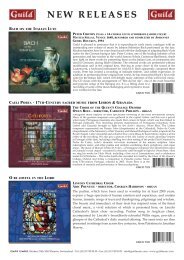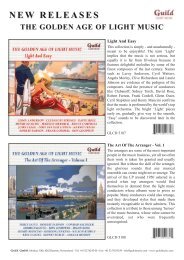Booklet
Booklet
Booklet
Create successful ePaper yourself
Turn your PDF publications into a flip-book with our unique Google optimized e-Paper software.
1912 he played it under Reger’s direction in Pforzheim, with the touring Meiningen Court Orchestra.<br />
His fiancée Frieda Grüters wrote home: ‘Reger told me Adolf is taking the place of Joachim; he has never<br />
heard the Concerto played in such a way.’ On 28 October 1912 Busch gave his first London rendering of<br />
the Concerto, with the LSO under Steinbach, again to acclaim; and from then on he was recognised as the<br />
work’s finest exponent. Early in 1913, as the new leader of the Konzertverein Orchestra (and its quartet),<br />
he mesmerised the Viennese audience and conductor Walter with his solo in the ‘Benedictus’ of the Missa<br />
solemnis. During the Great War, from his base in Vienna, Busch continued to tour the countries open to<br />
him and consolidated his reputation in central Europe as soloist and quartet leader. When peace came he<br />
was called to Joachim’s old teaching post in Berlin and became the busiest musician of his eminence in the<br />
world, giving a concert almost every night. One evening it might be a concerto, the next a quartet recital,<br />
the next a sonata programme with his partner Rudolf Serkin. He used his earnings as a soloist to subsidise<br />
his chamber music and put on a dazzling array of repertoire in his recitals – duos, trios, quartets, quintets,<br />
sextets, septets, octets. He was a pioneer of the chamber orchestra revival, experimenting with pick-up<br />
groups as early as 1916, although not until 1935 did he lead the regular ensemble of friends and pupils<br />
with which he performed and recorded Bach and Mozart. His summers were spent in relaxation – walking<br />
and climbing were favourite pastimes – and in composition. When the crisis of 1933 came, he was on the<br />
books of three publishers, Simrock, Breitkopf und Härtel and Eulenburg.<br />
As early as 1927, seeing how things were going politically in Germany, Adolf and Frieda Busch moved<br />
to Basel with their little daughter Irene and Serkin, who though only 12 years younger was like a son to<br />
them (he later married Irene). When the Nazis came to power in 1933, Busch was affronted by the insults<br />
and injustices meted out to the Jews. After experiencing anti-Semitic demonstrations against Serkin and<br />
the boycott of Jewish shops in Berlin on 1 April, he called it a day. He would not return to Germany, even as<br />
a visitor, for another 16 years. At a stroke he halved his income, said farewell to real success as a composer<br />
and lost his most appreciative audiences. In 1938 he boycotted Italy, where he was hugely popular, for<br />
similar reasons. The move to the United States, where being a Herr Professor Doktor counted for nothing<br />
and there was anti-German feeling – due not just to the war but to the stranglehold an earlier generation<br />
of Austro-German musicians had exerted on American music – was traumatic for him. Little interest was<br />
shown in him as a soloist and he ended up touring the country with a conductorless chamber orchestra,<br />
similar to the one he had led in Europe. Even here he was a pioneer, performing Schütz, Gabrieli, Purcell,<br />
Corelli and Rameau alongside his beloved Bach and Mozart. His performances and recordings of Handel’s<br />
Concerti grossi were among his finest achievements. In 1950 he helped to found the Marlboro summer<br />
school in Vermont, which still flourishes. He died at nearby Guilford on 9 June 1952.<br />
The saga of efforts to record Adolf Busch in the Beethoven Concerto was frustrating. By the late 1920s<br />
HMV and Columbia were vying for a recording: the former suggested using the Zürich Tonhalle Orchestra<br />
under Volkmar Andreae, then in the spring of 1930 actually booked the LSO, but Busch’s agents (prompted<br />
by his wife) objected to his being put on the cheaper plum label when his pupil Yehudi Menuhin was on<br />
the red label. Busch’s boycott of Germany from 1933 removed one of the main markets for a recording and<br />
so the situation arose where the Beethoven Concerto was available from German fiddlers such as Georg<br />
Kulenkampff, Max Strub and Riele Queling but not from the master. After emigrating to the U.S. in 1939,<br />
Busch was ignored by RCA Victor, who had a reciprocal arrangement with his European label HMV; but<br />
he was courted by Columbia and once he was over a 1940 heart attack, he began recording with Serkin<br />
and his quartet. Early in 1942, Fritz Busch conducted the New York Philharmonic-Symphony in a series<br />
of concerts for the orchestra’s centennial season at Carnegie Hall, and Adolf was soloist in four. On 29<br />
and 30 January he introduced New Yorkers to the Reger Concerto, in his own manuscript reworking, but<br />
most critics rejected it. On 7 and 8 February the Busch brothers again collaborated with the Philharmonic-<br />
Symphony, in the Beethoven Concerto, Adolf airing a new set of cadenzas written the previous year. The<br />
Sunday-afternoon CBS network broadcast was taken down by two home recordists and one of those<br />
documents has been released. It is an admirable corrective to the official Columbia recording, made<br />
next day at Liederkranz Hall. Unfortunately the production was delegated to the inexperienced Goddard<br />
Lieberson. Busch was palpably under strain in the opening movement, his nervousness exacerbated by<br />
Lieberson’s insisting he stand on a raised platform, which made him feel remote from his brother and the<br />
orchestra and brought him too close to the microphone. The resulting poor balance caused him to reject<br />
the recording, which was not issued until after his death. Had it been released at the time, it would have<br />
enhanced his reputation, as despite its faults it is one of the great readings of the Concerto.<br />
The frustration continued when, on 17 March 1949, Busch played the Concerto at the Radiohusets<br />
Koncertsal, Copenhagen, with the Danish State Radio Symphony Orchestra under Launy Grøndahl.<br />
The violinist was in terrific form, his big golden tone shining forth, and the orchestral musicians – with<br />
whom he was well acquainted from many visits to the Danish capital – gave him wholehearted support,<br />
as did their fine conductor. Sadly, Danish State Radio had not yet acquired tape recording facilities; and<br />
only one turntable was in operation for taking the performance down on discs: thus every time a disc<br />
4 5
















